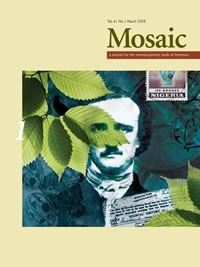Issue 41.1
Overview

General Issue
Published: March 2008
View the issue introduction or see the issue summary and contents below.
10 essays, totalling 192 pages
$19.95 CAD
This issue collects ten essays that take up concerns at the forefront of contemporary literary and critical theory. Reading fiction, sculpture, film, and philosophy, these essays contend with issues of race, nationalism, and colonialism; with discourses of sexuality and of wilderness; with the theorizing of vision, aesthetics, and neuro-narrativity.
Ecology, Coloniality, Modernity: Argentine Fictions of Tierra del FuegoLaura Barbas Rhoden This study focuses on two Argentine novels: La tierra de fuego by Sylvia Iparraguirre and Un piano en Bahía Desolación by Libertad Demitrópulos. The essay examines the authors’ representations of the transformation of Tierra del Fuego during an era of nineteenth-century British colonialism and Argentine nation-formation. | |
The “Hottentot Venus,” Sexuality, and the Changing Aesthetics of Race, 1650–1850Nicholas Hudson This essay examines the joint emergence of the sciences of “race” and “aesthetics,” particularly as mediated through the goddess Venus in European thought and art. A “double natured” goddess embodying both ideal beauty and carnal desire, Venus shows how the creation of these interdependent sciences resolved internal conflicts in Eurocentricism and male sexuality. | |
Buried in the Bedroom: Bearing Witness to Incest in Poe’s “The Tell-Tale Heart”Robert M. Kachur This essay locates Poe’s “The Tell-Tale Heart” within gothic fiction’s larger exploration of deviant sexuality. Trauma theory, clinical psychological research, and legal and medical history all help illuminate how the tale symbolically struggles to bear witness to a type of sexual trauma that still strongly resists articulation—male-on-male incest, and, more specifically, father-son incest. | |
Modern Female Aboriginal Subjectivity (In) the Land: Mourning Dove’s CogeweaDilia Narduzzi This essay argues that Mourning Dove’s pivotal novel, Cogewea, The Half-Blood, reworks several important categories for literary and theoretical thought. Cogewea reworks conventional notions of the modern, contestable subject positions of Aboriginal people in modernity, and the idea of “wilderness.” The essay reads Cogewea through modernist, ecological, and poststructuralist feminist lenses. | |
Derek Jarman’s “Ghostly Eye”: Prophetic Bliss and Sacrificial Blindness in BlueKate Higginson Theorizing vision and the visionary in Blue, this essay explores the film’s finale as a prophecy—Derek Jarman’s attempt to mitigate AIDS losses by appropriating the paradigm of blindness as insight to augur a queer h(e)aven—and as a formally reflexive examination of the allure and limitations of consolatory narratives of transcendence. | |
“Finding out things like that”: Film and the Search for Reality in BUtterfield 8Jennifer Haytock In BUtterfield 8, characters’ understanding of the world reflects an engagement with the pervasive culture of film and an awareness of film’s power to affect reality. This results in individuals’ intensified, but increasingly futile, attempts to grasp at truth about both themselves and their world. | |
On the Feeling Invested in Objects: Gonzalez’s Sculptures and Stewart’s Narratives of LongingMartin Bidney Ronald Gonzalez’s sculptures embody the four chief concerns of Susan Stewart in On Longing: Narratives of the Miniature, the Gigantic, the Souvenir, the Collection. Freudian-Lacanian and Marxian insights converge: longing tells of nostalgia for the lost (pre-)maternal Imaginary, for unalienated craft-labour. | |
Ken Wiwa and the Death of the FatherTaiwo Adetunji Osinubi In 1995, the Nigerian government executed nine men who subsequently became known as the Ogoni Nine, occasioning expressions of outrage that collated around the name and face of the writer and environmental activist Ken Saro-Wiwa. This essay examines the efforts of his son, Ken Wiwa, to reclaim the space of personal mourning amidst the political mobilization of his father’s life. | |
Reconciling Film Studies and Geography: Adolfo Bioy Casares’s La invención de MorelBenjamin Fraser When seen through Bergson’s philosophy, the cinematic machine at the heart of La invención de Morel bolsters recent attempts to reconcile the disciplines of film studies and cultural geography. Bioy Casares’s novel serves as a concrete, if fantastic, introduction to powerful methodological shifts that have brought film-space and city-space together. | |
Consciousness as Content: Neuronarratives and the Redemption of FictionGary Johnson This essay identifies a new subgenre of narrative fiction, “neuronarratives,” defined as works of fiction that incorporate advances in cognitive studies as a prominent theme, that compel novelists to struggle with consciousness as “content” and to reassess the value of narrative fiction. |